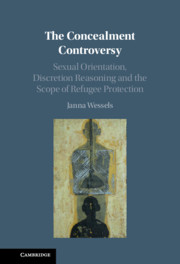 The Concealment Controversy
The Concealment Controversy Messing with the Definition
from Part II - Exploring the Limits of Protection
Published online by Cambridge University Press: 19 July 2021
Chapter 9 argues that a new layer of complication was added with the so-called human rights–based approach to refugee law. The challenge is that refugee protection is lesser in scope than human rights protection. That ‘lesser’ protection is usually located in the persecution element: while reference to human rights has opened up refugee law to a wider range of harms, not every human rights violation reaches the threshold of persecution. The chapter shows that one consequence of the human rights–based approach is the risk of conceptually merging Convention ground and persecution. According to the human rights approach, a violation of the freedom of religion or the freedom of thought can amount to persecution. In other words, prohibitions on the expression of the Convention grounds in themselves can be considered persecutory. The chapter reveals that this has led to the invention of an alternative or additional kind of harm that stands next to the harm that is inflicted in case the claimant does express the Convention ground – or is discovered in another way. This approach builds on and reinforces ‘discretion’ reasoning, because it distinguishes on the basis of the claimant’s future behaviour and requires ‘discretion’ under certain circumstances.
To save this book to your Kindle, first ensure [email protected] is added to your Approved Personal Document E-mail List under your Personal Document Settings on the Manage Your Content and Devices page of your Amazon account. Then enter the ‘name’ part of your Kindle email address below. Find out more about saving to your Kindle.
Note you can select to save to either the @free.kindle.com or @kindle.com variations. ‘@free.kindle.com’ emails are free but can only be saved to your device when it is connected to wi-fi. ‘@kindle.com’ emails can be delivered even when you are not connected to wi-fi, but note that service fees apply.
Find out more about the Kindle Personal Document Service.
To save content items to your account, please confirm that you agree to abide by our usage policies. If this is the first time you use this feature, you will be asked to authorise Cambridge Core to connect with your account. Find out more about saving content to Dropbox.
To save content items to your account, please confirm that you agree to abide by our usage policies. If this is the first time you use this feature, you will be asked to authorise Cambridge Core to connect with your account. Find out more about saving content to Google Drive.